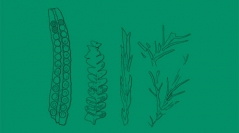

 Comptes Rendus Palevol
22 (20) - Pages 455-466
Comptes Rendus Palevol
22 (20) - Pages 455-466Amber and plant remains were discovered in the lower Cenomanian lignitic clay from La Gripperie-Saint-Symphorien (Charente-Maritime, western France). The amber mainly consists of scarce and infracentimetric pieces showing a wide range of sizes and colours. The shape of the amber grains greatly varies, including more or less cylindrical fragments of flows and spherical drops. Plants consist of foliar remains corresponding to isolated pinnae and pinnules of ferns (Matonia sp., Weichselia reticulata (Stokes & Webb, 1824) Fontaine emend. Alvin, 1971), leafy axes of conifers (Geinitzia reichenbachii (Geinitz, 1842) Hollick & Jeffrey, 1909, Pagiophyllum sp.) and leaves of angiosperms (including cf. Eucalyptolaurus depreii Coiffard, B.Gomez, Thiébaut & J.Kvaček and three morphotypes of undeterminable leaves). They are preserved as isolated cuticles, charcoalified compressions without cuticle, and external casts. Angiosperms are clearly the most abundant and diverse remains of the plant assemblage. This latter contrasts with most of Albian-Cenomanian coastal floras from the Aquitaine Basin, which are dominated by gymnosperms characterised by xeromorphic adaptations and tolerating halophytic conditions. Similar to the coeval sites of Puy-Puy (Charente-Maritime) and Jaunay-Clan (Vienne), the plant-rich clay from La Gripperie-Saint-Symphorien was probably deposited in innermost coastal environments heavily influenced by inland/continental freshwater.
Fossil resin, angiosperms, conifers, Matoniaceae, Cenomanian, Aquitaine Basin